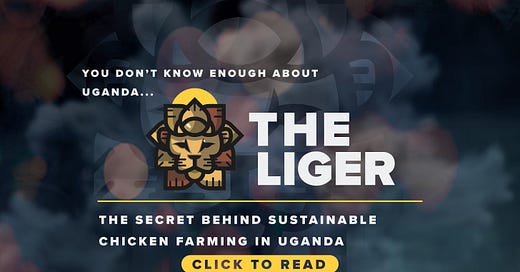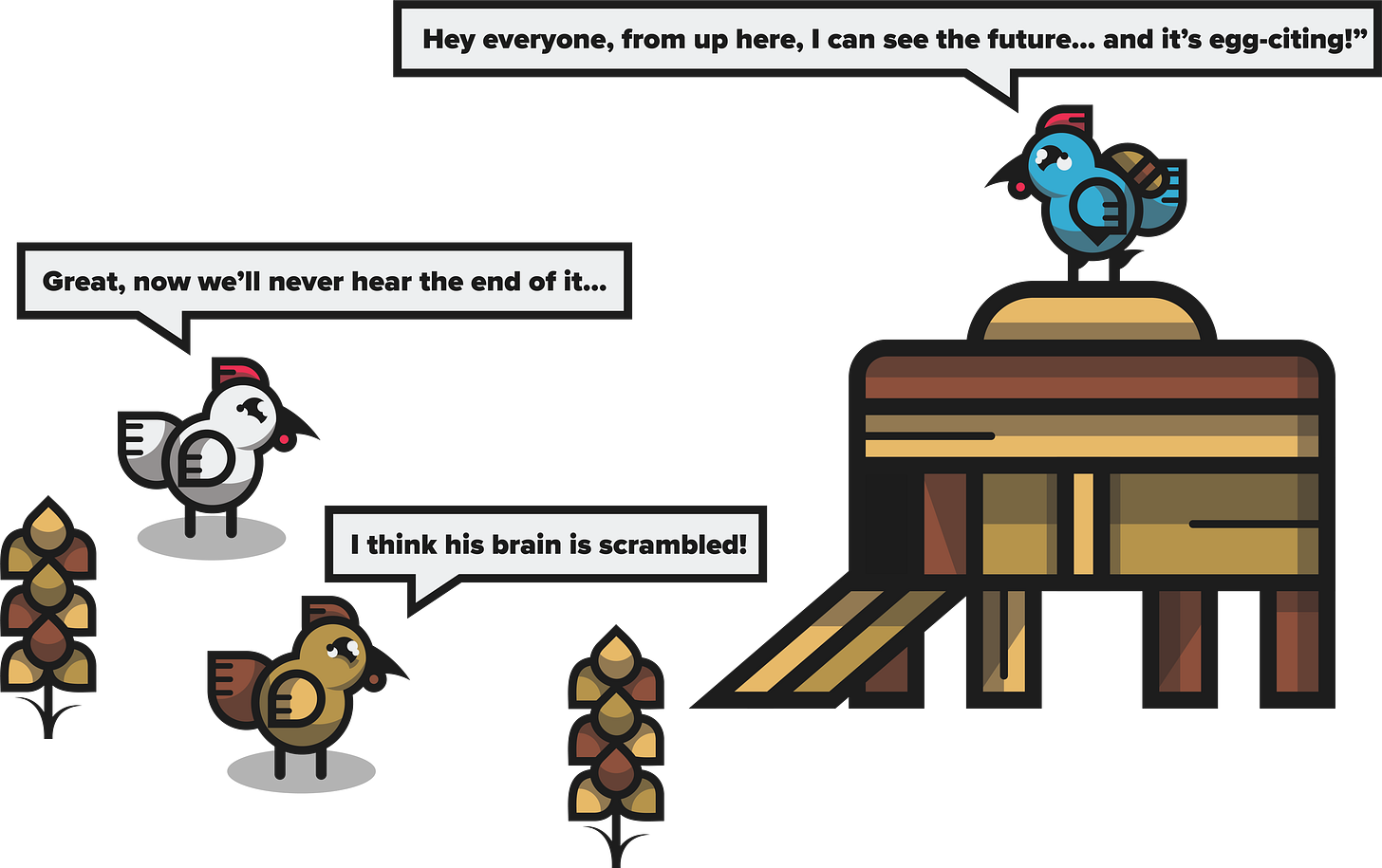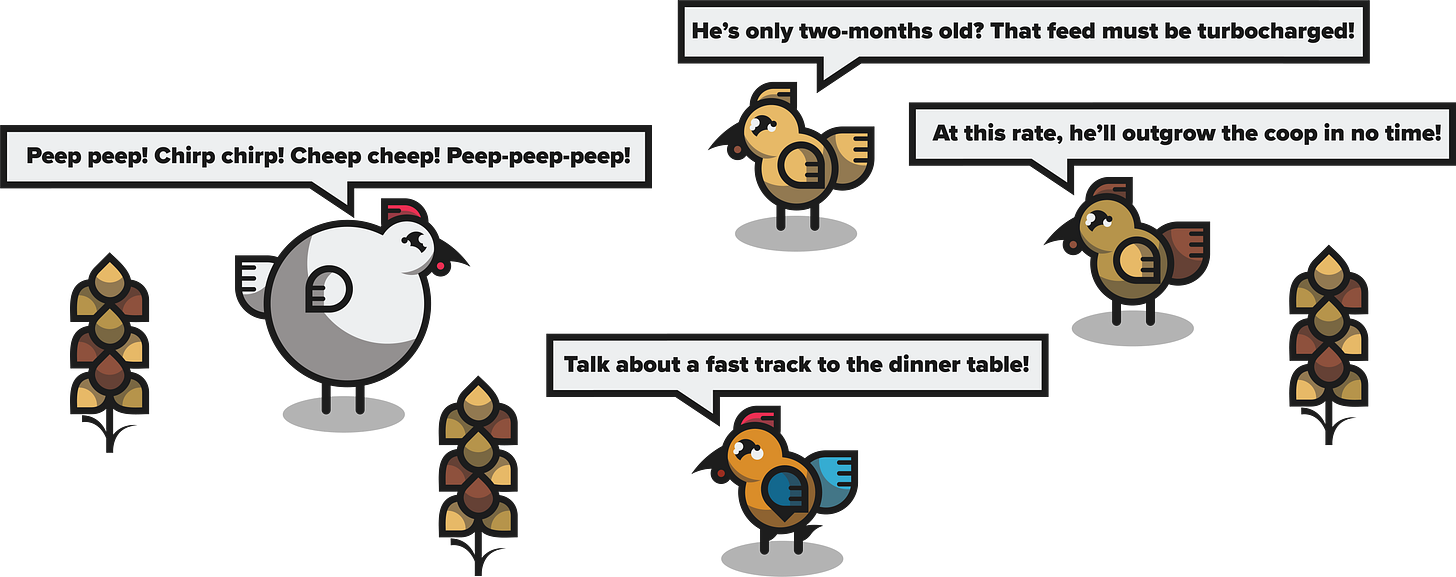The Secret Behind Sustainable Chicken Farming in Uganda
Sustainability Series. Backyard chicken farming, commercial grade farming, iodine insufficiency, Ugandan chicken farm, and more!
Okay, have you really thought about chickens?
Like, have you considered what chickens do for all of us?
Wefwafwa is building this chicken farm in Uganda, and I've spent months researching why chickens are so damn important—and wow, we do not give chickens enough credit for their role on this planet.
Let’s talk about it… And now, let’s visualize it!
Here’s what we’re discussing today:
How poultry farming ranges from backyard coops to automated commercial hatcheries.
You and I may not eat the same type of chicken.
The chicken may reflect your country’s farming practices.
Traditional chicken farming can be sustainable on larger scales.
What is ‘a chicken?’
And what exactly is on your dinner plate?
"It's a bird, a plane—no, tonight's dinner!"
Poultry farming varies widely, from simple backyard coops to fully automated, controlled environments.
In developing countries, indigenous poultry breeds are kept in simple shelters with minimal oversight that mainly rely on natural foraging or household scraps for food. Even the quality of the feed they might get is often inadequate. These backyard birds are often more resilient to disease, more self-sufficient foragers, and great in local farming setups. However, they are not as suitable in commercial poultry systems because they are only somewhat productive for poultry meat and egg production. Meaning, they're kinda skinny and don't lay enough eggs.
In developed countries, commercial poultry production systems predominantly use highly selected breeds for meat and egg production. These specialized chickens require optimal nutrition, disease protection and prevention, and strict confinement. These systems require intensive infrastructure and demand high-protein, low-fiber diets that require carefully curated chicken feed.
In developing regions, the expensive infrastructure and diet required for modern poultry farming is unattainable, partly due to the lack of skilled personnel needed to maintain high standards. Environmentally controlled housing demands significant oversight and high costs, making it feasible mainly for large-scale operations, especially in hot climates.
If you live in a developed country, you're likely consuming poultry products derived from these commercial poultry systems. Unless, of course, you own chickens or you're buying meat and eggs from a local farm.
Let’s talk about large-scale industries around the world.
In the United States, the broiler industry dominates poultry farming. Broilers are chickens bred and raised for their meat rather than eggs. These chickens are selected for fast growth rates, high feed efficiency, and larger muscle mass in their breasts and thighs. Layers are chickens bred and raised primarily for egg production. Meanwhile, backyard chicken farming is gaining popularity for sustainable and self-sufficient lifestyles
Similarly, the United Kingdom raises chickens for consumption via intensive farming. Intensive farming, also known as factory farming, raises a large number of chickens in confined spaces to maximize production efficiency. It focuses on high output and cost-effectiveness through controlled environments that manage growth, health, and feeding. This approach ensures a steady and affordable supply of chicken meat, but it raises ethical concerns.
Brazil, China, and Thailand use intensive farming to meet domestic and international demand for chicken meat. China is a major producer, supplying its vast population and export markets.
Alternatives to large-scale industries
On the other hand, India mixes traditional and small-scale poultry farming and emphasizes local breeds and regional practices. The breeds of chickens in India have varying sociocultural values and uses depending on local tradition.
France and Ethiopia employ free-range and organic chicken farming, emphasizing animal welfare and quality. Ethiopia primarily uses small-scale, traditional methods to integrate chickens into local agricultural systems. Chickens forage for food and are kept in basic coops, which support local food security and income and blend with the local culture and environment.
Why does their chicken taste better?
Universally, chicken is a staple in everyone's food production goals. While chicken production methods vary significantly around the world, they are shaped by a combination of economic, environmental, and social factors, with each country adapting its practices to fulfill the needs of its population.
Uganda Chicken Farming
Uganda poultry practices at a glance
Remember, in this coop, every peck counts.
The Mukono Zonal Agricultural Research and Development Institute (MUZARDI) introduced high-yield indigenous breeds to local farmers to meet increasingly high demands. Commercial poultry farming in Uganda is advancing with companies like Kenchic Uganda, which use hatcheries for broilers and layers. While the industry is moving towards modern and efficient farming practices, traditional methods still prevail in many rural communities.
Uganda’s poultry market full of opportunities
One special poultry farm
Wefwafwa Andrew previously built a mill for processing maize, and his newest project is the poultry farm. With the help of the local community, he set up a fenced perimeter with a large poultry house and surrounding vegetation. This dual-environmental approach allows chickens to roam and forage in the vegetation while also having the safety and overhead of the shelter. It also aims to be accessible by the local community for egg collection.
Iodine insufficiency in rural communities
Iodine-enriched feed and water can indirectly benefit human health through poultry products. Iodine is absorbed into the chicken’s bloodstream and distributed to various tissues, including the thyroid. During egg formation, iodine is transferred to the developing egg, primarily in the yolk.
So, chickens are pretty important.
The way we raise chickens showcases a country's practical approaches and innovation. It's about our chosen methods and how they reflect our values and impact our communities and resources. Moving from traditional to modern farming highlights our effort to increase efficiency while maintaining sustainability. Understanding these practices helps us make informed choices for our local food systems, ensures they remain reliable, and considers animal welfare.
Thank you for being a part of our community!
Explore engaging content by Wefwafwa Andrew, thoughtfully curated & art by Rex Soderlund.
The Liger is a unique Newsletter that connects you with the personal experience of a healthcare provider in Uganda, offering a genuine and engaging perspective on his life and community efforts.

















Great article; I'm so proud of you for all the hard work you've put into researching and writing this.